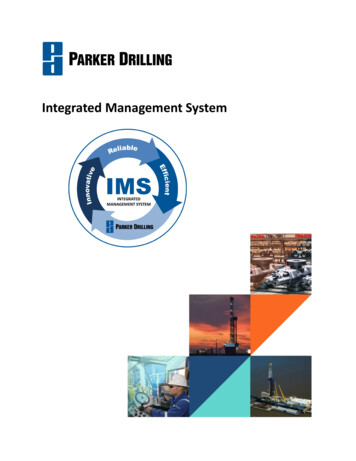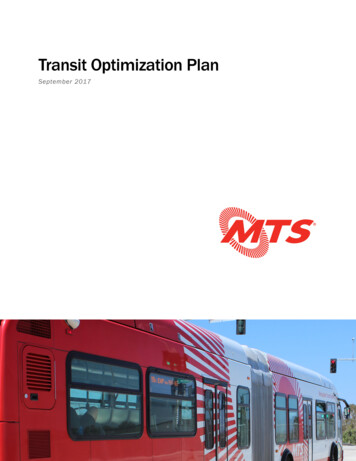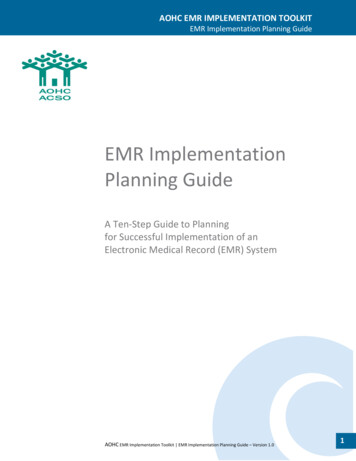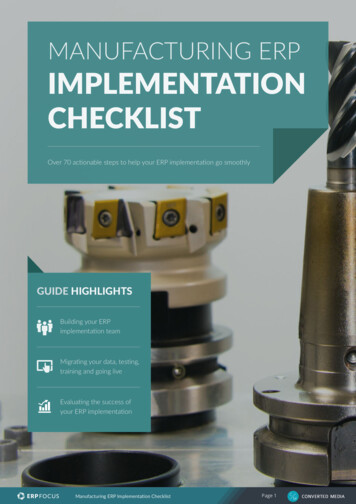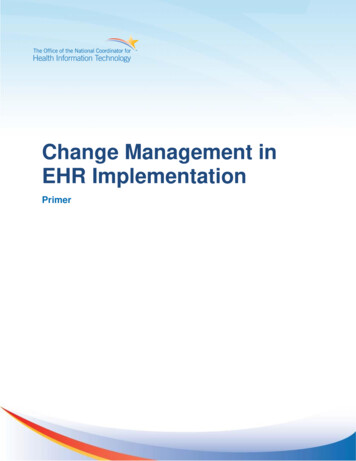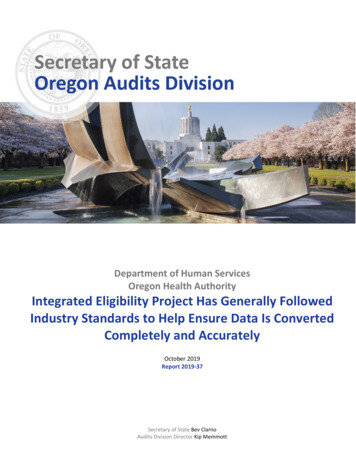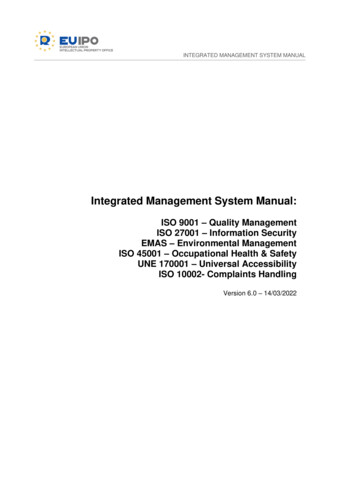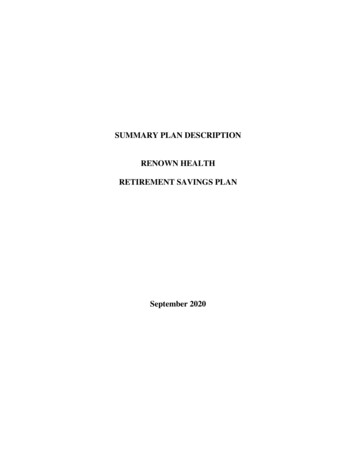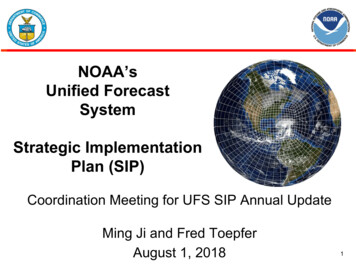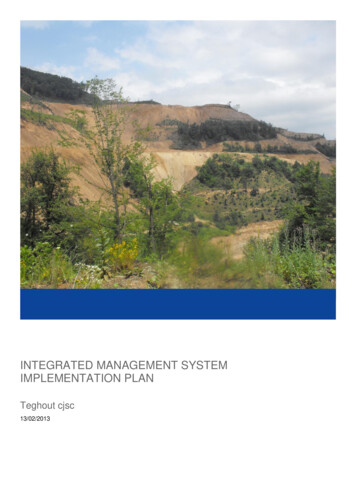
Transcription
INTEGRATED MANAGEMENT SYSTEMIMPLEMENTATION PLANTeghout cjsc13/02/2013
Quality ManagementIssue/revisionIssue 1Revision 1RemarksDraftFinalDate13/02/201306/03/2013Prepared byStephanie Tyrrelland Neal BarkerStephanie Tyrrelland Neal BarkerNeal BarkerNeal BarkerNeal BarkerNeal Barker3737237372K:\E09 - CorporateServices\Projects13\Teghout cjsc,37372K:\E09 CorporateServices\Projects13\Teghout cjsc,37372Revision 2SignatureChecked bySignatureAuthorised bySignatureProject numberReport numberFile referenceProject number: 37372Dated: 13/02/2013Revis ed:2 17Revision 3
Table of ContentsBackground and Introduction. 4Developing and Implementing an IMS . 5IMS Preparation Phase . 6IMS Planning Phase. 7IMS Implementation Phase . 8Monitoring of the IMS . 11Review and Certification. 12Appendices:Implementation Timetable and Diagrammatic Summary3 17
Background and IntroductionTeghout cjsc is committed to effective environmental, health and safety (EHS) management. To assist thiscommitment, Teghout cjsc is planning to develop and implement a robust integrated environmental, health andsafety management system (IMS) for the Teghout copper–molybdenum mine project, located in the Lori regionof Armenia. This document provides a plan for staged implementation of the IMS and all arrangements withinthe system.An Environmental and Social Due Diligence (ESDD) of the project has previously been undertaken, whichreviewed existing environmental and design documentation, as well as information on related public disclosureon the consultation process, against IFC Environmental and Social requirements and applicable EU legislation.As a result an Environmental and Social Action Plan (ESAP) has been developed detailing the commitmentsTeghout cjsc has agreed.It is a requirement of the ESAP that an EHS management system, including social aspects, will be developedand implemented and certifiable according to ISO 14001 and OHSAS 18001. It has been agreed betweenTeghout cjsc and EKF that certification will be achieved within six months of entering into the operationalphase. It is anticipated that the plant will start operation by mid-2015, therefore certification will be achieved bythe end of 2015. This implementation plan has been designed to achieve certification by July 2015; this willallow for slight flexibility on deadlines but ensure that certification will be achieved within six months ofoperation.WSP have been commissioned by Teghout cjsc to develop an Environmental Health and Safety (EHS)Management Implementation plan for the project. This document will identify the main stages of thedevelopment of the system, provide a summary of the requirements at each stage of the development andimplementation and provide a proposed timeline for the sequential implementation of the IntegratedManagement System (IMS) to combine the environmental standard ISO 14001 and the health and safetystandard OHSAS 18001 with a view to achieve certification before the end of 2015.In order to structure the management of the project’s EHS concerns and legal requirements, Teghout cjsc arecommitted to developing, implementing and maintaining an IMS, therefore closing out the associated actions inthe ESAP. The IMS will integrate the project’s systems and processes into one framework. This will enableTeghout cjsc to manage and monitor EHS matters as one unit. The IMS will:Ensure compliance with legal and other requirements;Manage significant EHSS risks;Promote internal and external stakeholder engagement;Improve resource efficiency.Project number: 37372Dated: 13/02/2013Revis ed:4 17
Developing and Implementing an IMSThe approach to IMS implementation set out below is based on the clauses within the ISO 14001 and OHSAS18001 standards, which are essentially parallel in structure, although there are differences in focus.The standards are based on a ‘plan-do-check-act’ methodology; this promotes continual improvement of theIMS and ensures that it is credible, robust and reliable.PLANDOACTCHECKThe IMS will provide a framework for managing the EHS risks associated with the project. The proposedstructure for development of the IMS is set out diagrammatically below:5 17
EHS PolicyRecords are kept at all stagesof the management systemStakeholder reports& feedbackManagementProgrammeCorporate KPIsAspects / RiskRegistersObjectives ntrolControlsEHS KPIsLegal RegisterIndividual laintsIncidentsChecking andCorrectiveActionsReviewIMS Preparation PhaseProject Commencement PhaseIt is proposed that an initial project commencement conference call will be held between Teghout cjsc and thecommissioned support consultants. This is an opportunity to discuss potential EHS risks, any currentmanagement practices or standards that are adopted at Group level, and whether these will be filtered down toTeghout cjsc. Detailed discussions between the consultants and Teghout cjsc will ensure that agreements aremade on the proposed plans and timescales to ensure that certification is achieved before the end of 2015.Review of existing EHSS management plans and gap analysisAn initial Baseline Review and Gap Analysis are to be undertaken to assess each of the requirements of bothISO 14001 and OHSAS 18001 clauses against any current arrangements and current compliance status.Project Inception Meeting and Implementation Schedule Training SessionA project inception meeting is proposed. This will be facilitated by the consultants and used as an opportunityto discuss the management of the IMS, the team and employee involvement and training. To ensurecommitment to the IMS and local site engagement, this should be attended by senior management andrelevant site personnel.Development of a draft EHSS Policy StatementThe development of an initial EHSS policy statement will also be undertaken during the preparation phase.The policy will detail the overall intentions and direction of the project with regards to EHSS performance. It willProject number: 37372Dated: 13/02/2013Revis ed:6 17
provide the framework for action and for the development of EHSS objectives and targets. The Policy will becommunicated to all employees and contractors as a minimum. It will be reviewed annually as part of themanagement review.IMS Planning PhaseIdentification of mine activities with environmental aspects and impacts and health and safety hazardsand risksThe planning phase involves identifying and defining various environmental aspects and related potentialimpacts that can result from the project along with the associated health and safety hazards and risks thatcould result from the activities, services and products of the project.Activities will be assigned to each stage of the mining projects. Primary activities will include, but are notlimited to:Land clearance and loggingMining ore excavation and removalDevelopment of roadsOre processing plant operationOverburden removalMining product / concentrationpacking, storage and removalLandscapinghandling,General transportWater channel diversionGeneral maintenanceConstruction of the mining process plantOffice and administration activitiesDevelopment of the tailings dam and pollutioncontrolActivities with an offsite interfaceThe purpose of the procedure is to ensure that all EHS aspects and hazards are identified and that thesignificance of their impacts and risks are assessed to permit improvement objectives and employ necessarycontrol measures. The procedure will address normal and abnormal activities such as the management ofcontractors and reasonably foreseeable emergency situations. A level of significance will be assigned to eachaspect and hazards with the intention to reduce impacts as low as practicable.A review of the commitments in the ESAP will also be undertaken; this will ensure that all aspects, which areconsidered to be significant for the project, are included within the IMS development.Aspects and Impacts register and hazard and risk register developmentThe output of this procedure will be an environmental and social aspects and impacts register and a hazardand risk register. This will need to be maintained and reviewed if operations change and on a regular basis.Identification of applicable EHS legislation and other requirements and the development of legalregisterAnother key part of the planning phase is the identification of applicable EHS legislation and other requirements(i.e. IFC performance standards and guidelines) to which Teghout cjsc subscribes. A procedure for thedevelopment of the register of EHS legislation and requirements will be developed to ensure all applicablelegislation and requirements have been identified and this is regularly reviewed and updated.Development of Objectives and TargetsObjectives and targets of the IMS will be set at this stage. These will be specific, measurable, attainable,relevant and timely (SMART). When these are developed, it is important to consider legal and otherrequirements, significant aspects and hazards, business requirements and any stakeholder interest. A series7 17
of relevant objectives and targets will be developed under a number of activities with associated EHSS aspects,for example:Accident and incident monitoring, inclusive of contractorsDelivery of training and communication plansResource efficiency, including energy consumptionReporting of compliance with permit conditions and other requirementsHabitat condition and habitat compensation progressionsPositive safety management e.g. safety culture / behavioural aspectsThese should be consistent with the EHS policy.Full review of the EHSS Policy StatementThis will be undertaken to ensure it is aligned with aspects, risks and objectives and targets.IMS Implementation PhaseThe implementation phase of the IMS is an imperative stage of the process. It is in the implementation that thetrue efficacy of EHSS management lies.Defining roles and responsibilitiesResponsibility and authority for implementing and maintaining specific aspects of the IMS will be defined. Areview of the existing EHS structure will be undertaken and any recommendations to Teghout cjsc will bemade. EHS management system roles, responsibilities and authorities will be defined at relevant functions andlevels within the organisation through system manuals, procedures and work instructions.Assessment of training needsAn identification of training needs for each job role will be undertaken. This will identify personnel whose workmay create a significant impact upon the environment or the health and safety of the workplace and wheretraining will be required in order to mitigate or minimise this risk.A training needs analysis will allow the development of a training procedure to train employees at each relevantfunction and level, ensuring awareness of the operating procedures, significant environmental aspects andworkplace hazards, their roles and responsibilities in the management of these and achieving conformance withthe policy and compliance with Armenian legislation and IFC performance standards.A documented training planThe training needs analysis will define the training required for each job role / employee, this will then allow forthe development of a documented training schedule. The schedule will be used as a plan for the delivery oftraining and also highlight any ‘refresher’ training that is required periodically, for example first aid training.Training development and delivery (through the remaining stages and on-going)Training is a key component of the implementation phase. It is envisaged that a review of existing training willbe undertaken and expanded. It is important to ensure that all staff are aware of the IMS operations and howtheir roles interacts with the system and other requirements. Training records will be maintained by HumanResources. Appropriate records will be monitored and reviewed on a scheduled basis.Management training examples:IMS Systems awareness for managersIMS awareness for all mine employeesProject number: 37372Dated: 13/02/2013Revis ed:8 17
IMS induction for all new employeesEHS induction for all contractorsInternal auditor trainingEmergency response training for all employeesOperational control training examples:First aidSafety risk specific training (Manual handling, electrical safety, use of work equipment, work at heighttraining, mining excavation safety training etc)Waste management trainingEnvironmental monitoring trainingDriver trainingCommunication procedureA Stakeholder Engagement Plan (SEP) which includes a grievance mechanism has already been developed byTeghout cjsc. This will need to be incorporated into the IMS and ensured that it is applied for all internal andexternal communications regarding EHS information. The procedure also includes grievances regardingcontractors’ activities and communications received by contractors. Integration of the SEP into the IMS willrequire the development of a procedure for the communication of information to identified external stakeholdersin accordance with IFC performance standard 1.Another area for consideration will be the change in the management process; therefore an internalcommunication procedure will be developed. This will define and detail the people responsible for overseeingthe IMS implementation and also responsible for dealing with queries or questions from internal stakeholders.Core systems documentationThis will include the formal issue of the procedure for the development of the legal register, aspects andimpacts register, hazard and risk register. This will also include procedures for other core systems elements asrequired in the ISO and OHSAS standards, such as ‘assessment of new and modified activities’ or ‘EHSSrecords maintenance’.During the preparation and planning phase we will review any existing procedures regarding, management,reporting, and document control. The review will enable the current procedures to be aligned and integratedinto the IMS and will avoid creating a parallel system.Development and Implementation of the Control of documents procedureA procedure to manage the control of all documents relating to the EHS management system will be developedand implemented. It will describe where documents are located and specify dates for review. It will ensure thatthe current versions of all documents are available and obsolete documents easily identifiable or are removed.As mentioned above, a review of existing procedures will be carried out before the development of newprocedures.9 17
Development and Implementation of a Contractor Management ProcedureTeghout cjsc will be responsible for the management of EHS matters for all contractors working on their behalf.The procedure will be developed and implemented to ensure all contractor operations and activities, likely tohave an EHS impact, are management appropriately. It will detail a pre work assessment of contractors’, EHSmanagement systems and performance. Also to be included in the management procedure are:Teghout cjsc’s EHS requirementsPre-work EHS inductionsReferences to safe work proceduresA defined responsible personDetails for reporting and EHS accidents, incidents or near missesReferences to emergency proceduresAs mentioned above, a review of existing procedures will be carried out before the development of newproceduresDevelopment and Implementation of Operational Control ProceduresOperations and activities associated with significant EHS aspects and hazards have been identified previouslyin the development of the IMS. Teghout cjsc’s top management need to ensure that there are sufficientcontrols in place through engineering design or work procedures and practices to control these EHS issues.The operational control procedures will be developed for each significant environmental aspect and health andsafety hazard to minimise EHS risk and ensure the system is maintained in accordance with the policy, theobjectives and targets, Armenian legislation and IFC PS.Operational control procedures for Teghout cjsc will include, but are not limited to:Storage of the overburdenAcid leachate generation and leakageRaw material storageManagement of the tailings and the tailings damOccupational noise assessmentNoise control and monitoringEngagement and communication with NGOsEnvironmental monitoring instruction for each monitoring aspectMine waste segregation, storage and management proceduresSurface water management proceduresLiquid effluent discharge managementEffluent treatment systems management (including maintenance)Storage and handling of hazardous and polluting materialsControl of dustSafety hazard procedures; entry of confined spaces, use of work equipment,excavators, management of working at height, control of lifting processes and lifting equipmentDam safety management and inspectionsProject number: 37372Dated: 13/02/2013Revis ed:10 17useof
Logging and landscaping managementManagement and assessment of stockpiles and slope stability.As mentioned above, a review of existing procedures will be carried out before the development of newprocedures.Development of Emergency ProceduresIdentification of potential accidents and emergency situations will be carried out for the development ofemergency procedures to mitigate EHS impacts associated with them. Emergency procedures will bedeveloped, tested and reviewed. Emergency procedures will include, but are not limited to:Response to emission limit value breachesFire responseSpill and response proceduresMajor incident plan, including public interface and evacuationAs mentioned above, a review of existing procedures will be carried out before the development of newprocedures.Monitoring of the IMSEstablishment of the Monitoring and Measuring ProgrammeThe monitoring and measuring programme will be developed to measure the key characteristics of the EHSmanagement system and Teghout cjsc’s operations and activities. The programme will include details ofcalibration and maintenance requirements and will ensure that records are retained. A monitoring plan hasbeen developed for the project; the procedures will therefore be developed in line with this plan. Procedureswill include the monitoring of EHS performance in line with the KPIs the ESAP and EHS objectives and targets.A regulatory compliance procedure will also be developed to manage EHS compliance. Detailed within theprocedures will be reporting requirements to top management.Legal and Other Requirements Compliance AssessmentA procedure for legal and other compliance assessments will be developed and records will be maintained todocument the results of the evaluation. This will be reported to top management.Interim ReportingIMS progress reporting to top management will be done. This will also be done in conjunction with the annualreport submitted to EKF on the progress of the ESAP items.Development of Emergency Response Monitoring and TestingProcedures will be developed and implemented for the testing of preparedness for emergency situations.Establishment of Audit ProgrammeIn order to ensure that the IMS conforms with the planned arrangements for EHS management and therequirements of ISO 14001 and OHSAS 18001 audits will be undertaken. Nomination and training of internalauditors will be undertaken. A schedule of audits will then be developed for both internal and external audits.Corrective and Preventive ActionsA procedure will be developed for handling and investigating EHS accidents and incidents. Roles andresponsibilities will be defined and instructions for the completion of necessary paperwork for reporting and11 17
recording the events. Where non-conformances have been identified, a procedure for assigning responsibility,handling, investigating them, taking actions to mitigate them and for initiating and completing corrective andpreventative actions will be developed. Any changes in procedures implemented as a result from correctiveand preventative actions implemented will be recorded on the procedure.Establishment of Contractor Assessment ProgrammeThe development of the programme will schedule assessments of contractors’ EHS performance.RecordsThe procedure will be implemented for the identification, maintenance and disposal of records. Records willinclude training records and results of audits and assessments.Review and CertificationManagement reviewThe management team will periodically review the IMS to ensure its continuing effectiveness, suitability andadequacy. The review will enable improvement and ensure the objectives and targets are aligned with thepolicy. It will include, but is not limited to:Review of results from auditsReview of the status of legal complianceReview of incidentsCommunication with external stakeholdersIdentify a certification bodyThe certification body will be identified and it will be ensured that this is internationally credible and approvedunder Armenian accreditation system.Certification audit – systems readinessA pre-certification audit will be undertaken; this will be a review of all the IMS documentation and a full tour ofthe mine and facilities.Certification audit – final implementation auditThe management systems certification process will then commence. An extensive review of documents andrecords, along with interviews and site auditing, will be undertaken by an external certification company.This will be completed in two stages; the first stage will be a systems readiness audit and a review of all theIMS documentation. It will involve a full tour of the mine and facilities. The second stage will be a full systemimplementation audit.Implement Audit Corrective ActionsOnce the certification audit has been undertaken any corrective actions that have been proposed will be closedout. Certification of the EMS arrangements to ISO14001 and the H&SMS to OHSAS 18001 should then beawarded.CertificationProject number: 37372Dated: 13/02/2013Revis ed:12 17
Project PlanA detailed project has been developed outlining the steps of the IMS development and implementation with the aim of gaining certification within six months of commencing DecJanIMS PREPARATION PHASEInitial Project Commencement Conference CallTeghout Collation of informationIMS Implementation Project Inception Meeting and InitialTraining SessionTeghout Senior Leadership TeamTeghout Line Management TeamConsultantsCurrent EHS Information Gap Analysis Study and Review ofExisting EHS Management Plan(s)Initial EHSS Policy Statement ProductionIdentification of EHS Management Team (Including Roles &Responsibilities)IMS PLANNING PHASEInitial identification of mine activities with environmental aspectsand impactsEvaluate environmental and social aspects and impacts forsignificantPreparation and finalisation of environmental and social aspectsand impacts registerIdentification of mine activities with health and safety hazardsand risks-To include meetings and discussions with the designteamEvaluation of significanceDevelopment of health and safety hazard and risk registerIndependent identification and evaluation of environmental andhealth and safety compliance requirements with applicableArmenian legislation.-To include the identification of emission limit valuesbased on national legislation and IFC guidance.Development of environmental register of Armenian legislationand other relevant performance requirements (IFC Standards)Development of health and safety register of legislation andother performance requirementsDevelopment of SMART EHSS Objectives and TargetsAgreement and ImplementationIMS IMPLEMENTATION PHASEDevelopment & Implementation of Core Management ‘Systems’Procedures and DocumentationDevelopment & Implementation of EHS ManualAssessment of staff training needs with a training needs analysis13 rMayJunJul
lopment of a documented training planDevelopment and delivery of training coursesDevelopment of Communication procedure-This will include the integration of the grievancemechanism for both internal and external stakeholders.Integrating the SEP into IMSDevelopment and Implementation of Control of documentsproceduresDevelopment and Implementation of a Contractor ManagementProcedureIdentification, development & implementation of OperationalControl Procedures-To include monitoring procedures for the EHS matters as identified in the monitoring plan e.g. wastemanagement, air quality.Establishment and implementation of emergency preparednessand response procedures.-To include the identification of potential EHS incidents, accidents and potential emergency situations.MONITORING OF THE IMSEstablishment of Monitoring & Measuring Programme-This will be developed in line with the monitoring planthat has been developed for the projects.To include the establishment of KPIs for EHSS performance monitoring and in line with the committedEHSS objectives and targetsInterim Reporting (High Level Objectives & Targets andProgress Towards System Implementation)-This will be done in conjunction with the annual report that will be submitted to EKF on the progress ofthe ESAP itemsLegal & Other Compliance Assessment-A workflow will be developed for an annual review ofcompliance.Records will be maintained to document the results ofthe evaluation.Development of Emergency Response Monitoring and TestingSystems (e.g. drills)Establishment of Audit Programme-This will be developed to ensure that the IMS conforms with the planned arrangements for EHS and also the requirements for the standards (ISO 14001 andOHSAS 18001)Development of an IMs internal and external auditscheduleNomination and training of IMS internal audit teamCommencement of scheduled internal auditsThe results of the audits will provide information tomanagement and form part of the management review.Corrective and Preventive Actions Procedures-Where nonconformities have been identified, actionswill be taken to mitigate their EHS impact.Investigations will be undertaken to determine causesand prevent recurrenceRecord to be maintainedAny necessary changes to the IMS will be documented.Establishment of Contractor Assessment ProgrammeRecords Identification-Necessary to demonstrate conformity.Project number: 37372Dated: 13/02/2013Revis ed:14 rMayJunJul
gement Review (Including Review of Entire System)This is should be undertaken annually.Identification of certification body, officially nominated andArmenian accredited.Certification auditSystem readiness auditCertification audit-Systems implementation final auditCertification15 rMayJunJul
AprilDevelopment of EHSPolicy StatementSeptemberDevelopment of EHS Objectives and TargetsMarchProject inception andcollation of informationMayOctoberMonitoring ProgrammeEHS Manual DevelopmentDevelopmentDecemberOperational Control ProceduresMarch - AprilPreparation PhaseMay - SeptemberPlanning PhaseAprilJulyMarchAspects, Impacts, Hazardsand RisksMayJuneRegister of legal andother requirementsProject number: 37372Dated: 13/02/2013Revis ed:OctoberPre certification auditOctober - AprilImplementation PhaseOctoberJanuaryMay - AugustMonitoring of the IMSAprilTraining Needs AnaylsisDecemberEmergency ProceduresFebruary16 17SeptemberPre Certification PreparationJulyEstablishing an Audit ProgrammeJuneSeptember - DecemberPre Certificaiton ChecksOctoberDecemberCertification to ISO 14001and OHSAS 18001DecemberCorrective and PreventiveCertification AuditActions ProcedurNovemberJuly
WSP Environment and Energy UKTel: 44 (0)16 1886 2639Fax: 44 161 886 2401www.wspgroup.co.uk
It is a requirement of the ESAP that an EHS management system, including social aspects, will be developed and implemented and certifiable according to ISO 14001 and OHSAS 18001. It has been agreed between Teghout cjsc and EKF that certification will be achieved within six months of entering into the operational phase.
